With director M. Night Shyamalan’s After Earth now playing in theaters, Sony Pictures recently invited us to the Virgin Galactic Spaceport in New Mexico for the press junket. As you can imagine, it was an amazing place to talk about the movie. If you’re not familiar with the plot, After Earth stars Will Smith and Jaden Smith as a father and son who crash land on a post-apocalyptic Earth, and it’s up to the son to fight for survival when the father is seriously injured.  For more on the film, watch three clips and some behind-the-scenes footage, and here are my video interviews with Will Smith, Jaden Smith, and screenwriter Gary Whitta.A few days before the movie got released, I spoke to Shyamalan on the phone. He talked about how he got involved in the project, making a film aimed at 12-15 year olds, the length of his first cut and if any of the deleted scenes will end up on the Blu-ray, if there are deleted scenes from his early work that have never been released, why he used the Sony F65 to shoot the film, IMAX, and much more. In addition, he also talked about his upcoming pilot Wayward Pines, Kickstarter, and his next movie. Hit the jump for more.Collider: I’ll start by saying congratulations, I really dug the movie.M.  NIGHT SHYAMALAN: That’s great, thank you.What’s interesting is they don’t make too many movies like this that are father son films that are aimed at young  12 - 15 year olds, it’s an interesting thing.  Talk a little bit about the fact that they don’t make too many movies aimed at that demographic that are good.SHYAMALAN: It’s kind of fascinating that you say it like that because that was the hope to make kind of the highest quality version of a movie that young people could identify with.  Jayden’s 14, obviously, so as the lead character that his way he sees the world is paramount to the movies, and not too young and not going too beyond that in terms of age.  It was nice to see.  I think the studio had success with him earlier and I kind of danced in this world of this age a lot, so there was some precedent for it, but you’re right it was nice to see and a part of kind of the precision of it.I definitely ask this of directors.  When you brought in the movie for the first time how long was your first cut?SHYAMALAN: You know it’s funny I’m really weird that way.  I’m so consistent that my director’s cuts are usually 20-25 minutes longer than the released version of the movies, and that was the same thing here, it was about 20-25.  It’s always the same thing, when I have my first cut, not the director’s cut, I’m sorry, my first cut, so it’s really my cut.  The first time I cut it together and I go, “How long is it?â€Â  it’s always 20-25 minutes longer than the final version.  And I always say the same thing to the editor, "Oh, I can see maybe trimming this five minutes, that’s it.â€Â  And then you keep trimming and trimming and trimming, and I’m the one that’s promoting the trimming.  I’m very ruthless about cutting.I’m definitely curious, were there certain scenes that were really tough to pull out?  Or, did it end up that the twenty minutes you pulled out were you like, “No, this was all pulled out for a reason.â€SHYAMALAN: Both, both - they were all pulled out for a reason, because a lot of times what you find is a scene is really strong in the wrong way and that becomes a problem.  It’s not that it’s weak, it’s that it’s really strong it’s causing a feeling of ending, or momentum to stop, or too much is being said, or there’s a redundancy later of something that has to be there so it’s saying too much too quickly. Yyu’re taking out only because the group of scenes around it are benefiting.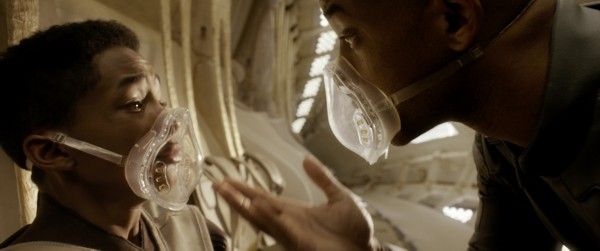 Obviously this movie has a lot of special effects, do you see the scenes that you cut out on an “extended cut†on the Blu-ray, do you see them as deleted scenes, or will they never see the light of day?SHYAMALAN: They’ll definitely be deleted scenes I don’t really like to do the extended cut.  This is the cut that I think worked best for the movie and the characters.  There are scenes that were right on the edge, but I always try to err on non-indulgence.  It's something that I’m very careful about, that I'm just leaning too hard into something.  You'll see it on the deleted scenes, because there’s a lot of really cool moments that just didn’t feel like they helped their brothers and sisters.You think maybe 10 minutes of deleted scenes eventually?SHYAMALAN:  Let me see…yeah, I could see that.  10 minutes would be right about there, 10-12.Jumping back to some of your previous work, I’m curious for some of your earlier work; Unbreakable, Signs, The Village, are there a lot of deleted scenes or stuff that you shot that has never seen the light of day?SHYAMALAN:  Not really, no, I’m thinking…I think.  I don’t want to be capricious when I answer the question, but I don’t think so.  I think I showed you the stuff that was seriously considered. I’m always curious about if people have stuff in the vault that they’re saving for a really long time down the road.SHYAMALAN:  Probably, I’d have to really think about it.  Maybe there was a scene or two that I held back for some reason and I can maybe reveal that at a later date.  I’d have to look at that to be honest, I’m not sure.I’m curious about what camera you decided to use on the film and why?
Obviously this movie has a lot of special effects, do you see the scenes that you cut out on an “extended cut†on the Blu-ray, do you see them as deleted scenes, or will they never see the light of day?SHYAMALAN: They’ll definitely be deleted scenes I don’t really like to do the extended cut.  This is the cut that I think worked best for the movie and the characters.  There are scenes that were right on the edge, but I always try to err on non-indulgence.  It's something that I’m very careful about, that I'm just leaning too hard into something.  You'll see it on the deleted scenes, because there’s a lot of really cool moments that just didn’t feel like they helped their brothers and sisters.You think maybe 10 minutes of deleted scenes eventually?SHYAMALAN:  Let me see…yeah, I could see that.  10 minutes would be right about there, 10-12.Jumping back to some of your previous work, I’m curious for some of your earlier work; Unbreakable, Signs, The Village, are there a lot of deleted scenes or stuff that you shot that has never seen the light of day?SHYAMALAN:  Not really, no, I’m thinking…I think.  I don’t want to be capricious when I answer the question, but I don’t think so.  I think I showed you the stuff that was seriously considered. I’m always curious about if people have stuff in the vault that they’re saving for a really long time down the road.SHYAMALAN:  Probably, I’d have to really think about it.  Maybe there was a scene or two that I held back for some reason and I can maybe reveal that at a later date.  I’d have to look at that to be honest, I’m not sure.I’m curious about what camera you decided to use on the film and why?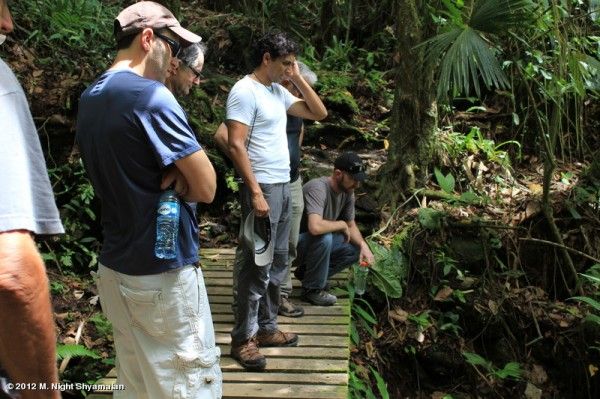 SHYAMALAN:  Well you know this is my first movie I shot not film.  I always thought I was going to be the film guy until I died.  I kind of tested – the cinematographer Peter Suschitzky, he had me do tests on all the digital cameras with the film camera and see which one would look best in the forests and jungles where we were shooting, and I just fell in love with this camera.  It’s called the Sony F65, and ironically I made the film for Sony, so you can imagine how happy they were, but that really had nothing to do with the decision.  It was a brand new camera; in fact we used it for the very first time.  In know Oblivion also used it, but we shot with it first.  I used camera “001â€, which was an amazing thing.  Obviously our technicians and camera people were a little nervous in the jungle with the very first camera being made.  It’s a wonderful camera that captures colors, such pungent colors.  I love colors and actually I hired Peter Suschitzky for his use of colors on this film.  He really made the golds in the cockpit, and the greens obviously in the jungle, and the subtleties of their world on Nova Prime - how to get all the richness of those colors out. Its super sharp in a good way, like film.  You know what it is?  Its sharpness reminded me most of film.  It didn’t go into a place where it became too slick.  It had a film warmth to it, whereas normally I find a lot of the digital cameras have a little coldness to them, a little silvery grey quality. For me what I’ve noticed is it’s not so much about the digital camera it’s about where you’re watching it being projected, because I’ve seen some really shitty digital projection.SHYAMALAN:  Right, right, right.Because the Alexa and the Epic - and honestly the Sony fF65 is amazing camera.  The look of your film and the look of Oblivionare both really fantastic.SHYAMALAN: Oh great, I’m a huge fan of it, I really am.  It’s funny because I don’t know if I’m being biased but I always find the Alexa and some of the other digital cameras have a baseline of coldness.  It’s a slightly baseline and if that’s your style then it’s perfect.  The cooler colors, if that’s your baseline you’re in heaven.  Fincher, obviously, that’s his baseline so digital cameras will be perfect for him.It’s also interesting what you can do in Avid, and what you can do in post in terms of adjusting your look.  But you’re right, obviously if your raw file is looking a certain way there’s only certain things you can do with it.
SHYAMALAN:  Well you know this is my first movie I shot not film.  I always thought I was going to be the film guy until I died.  I kind of tested – the cinematographer Peter Suschitzky, he had me do tests on all the digital cameras with the film camera and see which one would look best in the forests and jungles where we were shooting, and I just fell in love with this camera.  It’s called the Sony F65, and ironically I made the film for Sony, so you can imagine how happy they were, but that really had nothing to do with the decision.  It was a brand new camera; in fact we used it for the very first time.  In know Oblivion also used it, but we shot with it first.  I used camera “001â€, which was an amazing thing.  Obviously our technicians and camera people were a little nervous in the jungle with the very first camera being made.  It’s a wonderful camera that captures colors, such pungent colors.  I love colors and actually I hired Peter Suschitzky for his use of colors on this film.  He really made the golds in the cockpit, and the greens obviously in the jungle, and the subtleties of their world on Nova Prime - how to get all the richness of those colors out. Its super sharp in a good way, like film.  You know what it is?  Its sharpness reminded me most of film.  It didn’t go into a place where it became too slick.  It had a film warmth to it, whereas normally I find a lot of the digital cameras have a little coldness to them, a little silvery grey quality. For me what I’ve noticed is it’s not so much about the digital camera it’s about where you’re watching it being projected, because I’ve seen some really shitty digital projection.SHYAMALAN:  Right, right, right.Because the Alexa and the Epic - and honestly the Sony fF65 is amazing camera.  The look of your film and the look of Oblivionare both really fantastic.SHYAMALAN: Oh great, I’m a huge fan of it, I really am.  It’s funny because I don’t know if I’m being biased but I always find the Alexa and some of the other digital cameras have a baseline of coldness.  It’s a slightly baseline and if that’s your style then it’s perfect.  The cooler colors, if that’s your baseline you’re in heaven.  Fincher, obviously, that’s his baseline so digital cameras will be perfect for him.It’s also interesting what you can do in Avid, and what you can do in post in terms of adjusting your look.  But you’re right, obviously if your raw file is looking a certain way there’s only certain things you can do with it.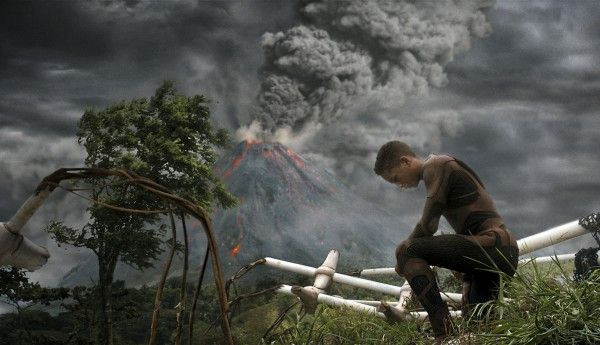 SHYAMALAN:  Yeah, you don’t often try to redefine the whole movie in post.  You don’t really try to recreate it. The really interesting thing with digital was Peter was actually color timing it on the set, so when I was watching it on the monitor it was color timed already.  So I’m really getting a perfect view of it.  And I’m saying hey, “Can we make the key light stronger?  Can we have more of a sense of progression from the previous scene that we’re at the end of the day?  How can we convey the characters isolation a little more with accurate lighting?â€Â  Things like that, you can actually be confident that you’re tweaking the real image there, which is fascinating.So does this mean that you’ve fully converted to digital?SHYAMALAN:  I don’t know, because I’m writing a new one and I’m like, “Huh, maybe the film camera is better for this one.â€Â  So I’m not quite on the train forever.A lot of the houses that develop film are shutting down, so I think it really is just a matter of time before a lot of filmmakers are going to sort of be forced.SHYAMALAN:  I know, it’s sad.  I wish it wasn’t that way.  I wish there were always options so we can decide which is the best style for our film.Michael Bay is using this brand new IMAX digital 3D camera for Transformers 4, it’s like their new thing so you can get IMAX resolution but the camera’s really small.  Have you thought about shooting with IMAX cameras on any of your previous films?SHYAMALAN: Yeah, on this particularly movie I had thought about it a lot, about whether to shoot IMAX.  At the time I had made a decision that it was a little too tricky for me in the jungles where we were with a child to do the kind of setups that are necessary.  So if they have a new technology I can see  one day it becoming a wonderful choice.  I think it would have been really interesting for After Earth.You’re doing Wayward Pines, which is TV.  For me, TV is the most exciting it’s ever been with the abundance of cable channels and - there’s just so many great shows out there.  What got you involved with TV and what can you tell people about it?SHYAMALAN:  I believe exactly what you just said is the first thing.  I was really struck by the tonal storytelling going on on TV.  For example, I love The Killing, I love Homeland and Mad Men, all those shows that lean into the tone of things. That was really inspiring, but it was really this particular pilot, when they sent it to me, that really stuck me.  I was like, “Wow, this would be so fun to do.  This kind of vibe of I don’t know what’s going on.â€Â  When I read the pilot I had no idea what was going on and that’s such a fun feeling.
SHYAMALAN:  Yeah, you don’t often try to redefine the whole movie in post.  You don’t really try to recreate it. The really interesting thing with digital was Peter was actually color timing it on the set, so when I was watching it on the monitor it was color timed already.  So I’m really getting a perfect view of it.  And I’m saying hey, “Can we make the key light stronger?  Can we have more of a sense of progression from the previous scene that we’re at the end of the day?  How can we convey the characters isolation a little more with accurate lighting?â€Â  Things like that, you can actually be confident that you’re tweaking the real image there, which is fascinating.So does this mean that you’ve fully converted to digital?SHYAMALAN:  I don’t know, because I’m writing a new one and I’m like, “Huh, maybe the film camera is better for this one.â€Â  So I’m not quite on the train forever.A lot of the houses that develop film are shutting down, so I think it really is just a matter of time before a lot of filmmakers are going to sort of be forced.SHYAMALAN:  I know, it’s sad.  I wish it wasn’t that way.  I wish there were always options so we can decide which is the best style for our film.Michael Bay is using this brand new IMAX digital 3D camera for Transformers 4, it’s like their new thing so you can get IMAX resolution but the camera’s really small.  Have you thought about shooting with IMAX cameras on any of your previous films?SHYAMALAN: Yeah, on this particularly movie I had thought about it a lot, about whether to shoot IMAX.  At the time I had made a decision that it was a little too tricky for me in the jungles where we were with a child to do the kind of setups that are necessary.  So if they have a new technology I can see  one day it becoming a wonderful choice.  I think it would have been really interesting for After Earth.You’re doing Wayward Pines, which is TV.  For me, TV is the most exciting it’s ever been with the abundance of cable channels and - there’s just so many great shows out there.  What got you involved with TV and what can you tell people about it?SHYAMALAN:  I believe exactly what you just said is the first thing.  I was really struck by the tonal storytelling going on on TV.  For example, I love The Killing, I love Homeland and Mad Men, all those shows that lean into the tone of things. That was really inspiring, but it was really this particular pilot, when they sent it to me, that really stuck me.  I was like, “Wow, this would be so fun to do.  This kind of vibe of I don’t know what’s going on.â€Â  When I read the pilot I had no idea what was going on and that’s such a fun feeling.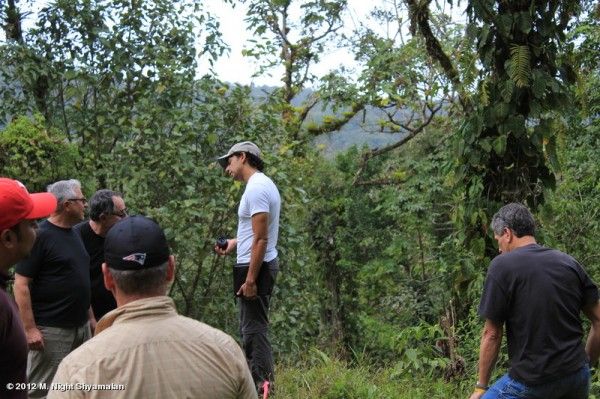 So you’ve shot this then?SHYAMALAN:  No, I’m going to shoot it in a couple months.Right on, what can you tell people about it?SHYAMALAN:  It’s starring Matt Dillon and Melissa Leo, and it’s basically a secret service agent goes to investigate the disappearance of another secret service agent who he’s had an affair with.  On the way there he gets into a car accident and when he wakes up he’s just outside this little town Wayward Pines, and he goes into the town everyone is acting incredibly weird and he soon finds out that he can’t leave.You mentioned that you’re writing something, I’m not sure if you’re the type of person who likes to talk about future projects, but maybe you can mention what genre it is.SHYAMALAN:  No, I can’t.  I just don’t like talking about it.  The reason is it sometimes steals the magic, for whatever reason, out of the air.  Like when you say, “I’m in love with Stacy, blah, blah, blah,†suddenly it sounds really cheesy, but before you said it out loud it was so perfect.  I want to sustain as much of that – that’s usually what’s behind a lot of my secrecy is, just trying to sustain it for me.  But, I can tell you this, it’s a really small movie.So could this actually be something that goes to Sundance or a film festival?SHYAMALAN:  It could, it could.  I want to make a bunch of small movies.  I’m really interested in that for me in the future.That’s an interesting change, especially after After Earth, and you’ve made some bigger films if you will.SHYAMALAN:  I know, I think that would be a cool juxtaposition to see storytelling in a very small movie after a big movie like this.I’m definitely going to ask you your thoughts on Kickstarter, obviously you must have heard all the people that are currently using it.  Is that something you would ever consider for a future project, or do you have enough connections with the studio that making a small movie is still not an issue for you?SHYAMALAN:  So wait, tell me who’s using it.Veronica Mars got their financing through Kickstarter.  Zach Braff got his financing through Kickstarter for his new small budget drama.  There are a lot of filmmakers that are currently pushing into getting financing through the general public.
So you’ve shot this then?SHYAMALAN:  No, I’m going to shoot it in a couple months.Right on, what can you tell people about it?SHYAMALAN:  It’s starring Matt Dillon and Melissa Leo, and it’s basically a secret service agent goes to investigate the disappearance of another secret service agent who he’s had an affair with.  On the way there he gets into a car accident and when he wakes up he’s just outside this little town Wayward Pines, and he goes into the town everyone is acting incredibly weird and he soon finds out that he can’t leave.You mentioned that you’re writing something, I’m not sure if you’re the type of person who likes to talk about future projects, but maybe you can mention what genre it is.SHYAMALAN:  No, I can’t.  I just don’t like talking about it.  The reason is it sometimes steals the magic, for whatever reason, out of the air.  Like when you say, “I’m in love with Stacy, blah, blah, blah,†suddenly it sounds really cheesy, but before you said it out loud it was so perfect.  I want to sustain as much of that – that’s usually what’s behind a lot of my secrecy is, just trying to sustain it for me.  But, I can tell you this, it’s a really small movie.So could this actually be something that goes to Sundance or a film festival?SHYAMALAN:  It could, it could.  I want to make a bunch of small movies.  I’m really interested in that for me in the future.That’s an interesting change, especially after After Earth, and you’ve made some bigger films if you will.SHYAMALAN:  I know, I think that would be a cool juxtaposition to see storytelling in a very small movie after a big movie like this.I’m definitely going to ask you your thoughts on Kickstarter, obviously you must have heard all the people that are currently using it.  Is that something you would ever consider for a future project, or do you have enough connections with the studio that making a small movie is still not an issue for you?SHYAMALAN:  So wait, tell me who’s using it.Veronica Mars got their financing through Kickstarter.  Zach Braff got his financing through Kickstarter for his new small budget drama.  There are a lot of filmmakers that are currently pushing into getting financing through the general public.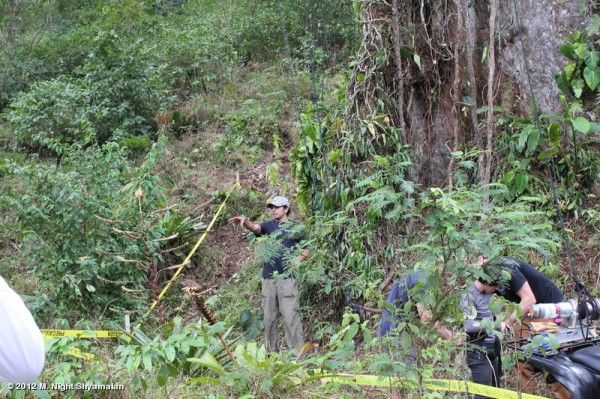 SHYAMALAN:  Wow - by the way I joked about this about a couple years ago not knowing that people were going to start doing this.  It’s wild.  It’s very empowering.When you’re done with interviews today look up Kickstarter, Veronica Mars, Zach Braff, Wish I Was Here and read all about what’s been going on, the feedback from people, some people are against filmmakers – there’s pros and cons to using it in terms of people’s reactions.SHYAMALAN:  Oh really, just quickly, what’s the negative to these guys that are doing it?The negative is that average people are objecting that the general public is paying to do Veronica Mars when it’s a studio owned gig.  So essentially fans are paying for something that they feel the studio should pay for.  With Zach Braff, he was offered financing, but I think the financing he was offered came with casting certain people, and maybe not having final say in certain things, and he wanted to cast certain actors for the role and have artistic freedom.  So basically he took money from his fans to have artistic freedom to make the film that he wants to make without any sort of compromise.SHYAMALAN:  Right, and the dig against him is?That he’s being offered financing through the studio – basically because he has money, you know, he’s made money from Scrubs, he’s been paid, he’s not exactly poor and he’s asking for 2-3 million dollars from people.  See what I’m saying?SHYAMALAN: I see the angle now; yeah, yeah, yeah.  Interesting, fascinating – oh my god, I’m going to read up all on this.
SHYAMALAN:  Wow - by the way I joked about this about a couple years ago not knowing that people were going to start doing this.  It’s wild.  It’s very empowering.When you’re done with interviews today look up Kickstarter, Veronica Mars, Zach Braff, Wish I Was Here and read all about what’s been going on, the feedback from people, some people are against filmmakers – there’s pros and cons to using it in terms of people’s reactions.SHYAMALAN:  Oh really, just quickly, what’s the negative to these guys that are doing it?The negative is that average people are objecting that the general public is paying to do Veronica Mars when it’s a studio owned gig.  So essentially fans are paying for something that they feel the studio should pay for.  With Zach Braff, he was offered financing, but I think the financing he was offered came with casting certain people, and maybe not having final say in certain things, and he wanted to cast certain actors for the role and have artistic freedom.  So basically he took money from his fans to have artistic freedom to make the film that he wants to make without any sort of compromise.SHYAMALAN:  Right, and the dig against him is?That he’s being offered financing through the studio – basically because he has money, you know, he’s made money from Scrubs, he’s been paid, he’s not exactly poor and he’s asking for 2-3 million dollars from people.  See what I’m saying?SHYAMALAN: I see the angle now; yeah, yeah, yeah.  Interesting, fascinating – oh my god, I’m going to read up all on this.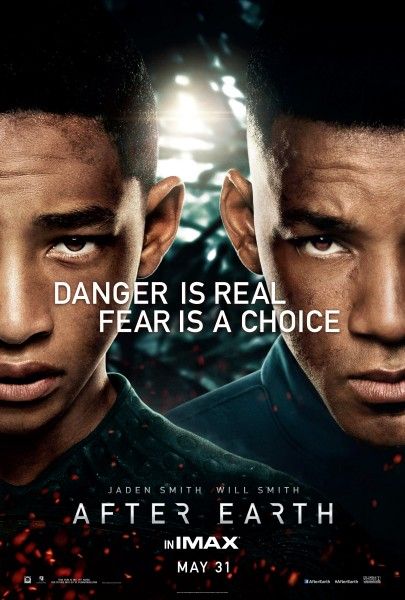 Getting back into your film, one of the things you’ve become known for, not all the time, but for twists.  What’s interesting for people about After Earth is there is no twist.  This is a straight forward story.  I’m curious if there was ever any consideration of a twist?  And how did the project change from when you first got involved to what everyone is going to see on the screen?SHYAMALAN:  There was never any consideration about that kind of thing.  I never think of it in terms of plot devices like that.  It was always meant to be kind of a play between a father and a son at the center of it all.  So that was always kind of its clear and clean intention.  In terms of the changing of it, I think the muscularity of the movie every draft got stronger and stronger.  It went from a drama – drama to action ratio kept changing more into a balance.So there was no major thing?  You know, sometimes in the development process there can be a radical change.SHYAMALAN:  The only thing I can think of is the history of the family changed.  What was the thing -I knew there was an issue between the two of them, and the kind of family trauma came half way through me figuring out the script.
Getting back into your film, one of the things you’ve become known for, not all the time, but for twists.  What’s interesting for people about After Earth is there is no twist.  This is a straight forward story.  I’m curious if there was ever any consideration of a twist?  And how did the project change from when you first got involved to what everyone is going to see on the screen?SHYAMALAN:  There was never any consideration about that kind of thing.  I never think of it in terms of plot devices like that.  It was always meant to be kind of a play between a father and a son at the center of it all.  So that was always kind of its clear and clean intention.  In terms of the changing of it, I think the muscularity of the movie every draft got stronger and stronger.  It went from a drama – drama to action ratio kept changing more into a balance.So there was no major thing?  You know, sometimes in the development process there can be a radical change.SHYAMALAN:  The only thing I can think of is the history of the family changed.  What was the thing -I knew there was an issue between the two of them, and the kind of family trauma came half way through me figuring out the script.

